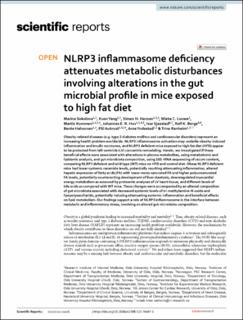| dc.contributor.author | Sokolova, Marina | |
| dc.contributor.author | Yang, Kuan | |
| dc.contributor.author | Hansen, Simen Hyll | |
| dc.contributor.author | Louwe, Mieke C. | |
| dc.contributor.author | Kummen, Martin | |
| dc.contributor.author | Hov, Johannes Espolin Roksund | |
| dc.contributor.author | Sjaastad, Ivar | |
| dc.contributor.author | Berge, Rolf Kristian | |
| dc.contributor.author | Halvorsen, Bente | |
| dc.contributor.author | Aukrust, Pål | |
| dc.contributor.author | Yndestad, Arne | |
| dc.contributor.author | Ranheim, Trine | |
| dc.date.accessioned | 2021-05-07T12:50:49Z | |
| dc.date.available | 2021-05-07T12:50:49Z | |
| dc.date.created | 2020-12-18T10:57:37Z | |
| dc.date.issued | 2020 | |
| dc.Published | Scientific Reports. 2020, 10:21006 1-16. | |
| dc.identifier.issn | 2045-2322 | |
| dc.identifier.uri | https://hdl.handle.net/11250/2754195 | |
| dc.description.abstract | Obesity-related diseases (e.g. type 2 diabetes mellitus and cardiovascular disorders) represent an increasing health problem worldwide. NLRP3 inflammasome activation may underlie obesity-induced inflammation and insulin resistance, and NLRP3 deficient mice exposed to high fat diet (HFD) appear to be protected from left ventricle (LV) concentric remodeling. Herein, we investigated if these beneficial effects were associated with alterations in plasma metabolites, using metabolomic and lipidomic analysis, and gut microbiota composition, using 16S rRNA sequencing of cecum content, comparing NLRP3 deficient and wild type (WT) mice on HFD and control diet. Obese NLRP3 deficient mice had lower systemic ceramide levels, potentially resulting attenuating inflammation, altered hepatic expression of fatty acids (FA) with lower mono-saturated FA and higher polyunsaturated FA levels, potentially counteracting development of liver steatosis, downregulated myocardial energy metabolism as assessed by proteomic analyses of LV heart tissue, and different levels of bile acids as compared with WT mice. These changes were accompanied by an altered composition of gut microbiota associated with decreased systemic levels of tri-methylamine-N-oxide and lipopolysaccharide, potentially inducing attenuating systemic inflammation and beneficial effects on lipid metabolism. Our findings support a role of NLRP3 inflammasome in the interface between metabolic and inflammatory stress, involving an altered gut microbiota composition. | en_US |
| dc.language.iso | eng | en_US |
| dc.publisher | Nature Research | en_US |
| dc.rights | Navngivelse 4.0 Internasjonal | * |
| dc.rights.uri | http://creativecommons.org/licenses/by/4.0/deed.no | * |
| dc.title | NLRP3 inflammasome deficiency attenuates metabolic disturbances involving alterations in the gut microbial profile in mice exposed to high fat diet | en_US |
| dc.type | Journal article | en_US |
| dc.type | Peer reviewed | en_US |
| dc.description.version | publishedVersion | en_US |
| dc.rights.holder | Copyright 2020 The Author(s). | en_US |
| dc.source.articlenumber | 21006 | en_US |
| cristin.ispublished | true | |
| cristin.fulltext | original | |
| cristin.qualitycode | 1 | |
| dc.identifier.doi | 10.1038/s41598-020-76497-1 | |
| dc.identifier.cristin | 1861476 | |
| dc.source.journal | Scientific Reports | en_US |
| dc.source.40 | 10:21006 | |
| dc.identifier.citation | Scientific Reports. 2020, 10, 21006 | en_US |
| dc.source.volume | 10 | en_US |

